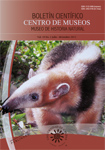Authors
Abstract
The purpose of this work was to study the reproductive biology, schedules and methods of artificial pollination in tamarillo Cyphomandra betacea, Manzano cultivar growing in a town in the department of Nariño (Colombia), located at 2,100 m.a.s.l. with a temperature of 13°C. One thousand (1,000) flower buds of 0.5 cm in length were marked. Every eight days and during 40 days when fertilization occurred, measurements in mm of the flower bud length and diameter of the corolla, equatorial diameter of the calyx, length and diameter of the ovary, length of the filament, length of the style, length and width of the anther, pollen viability and pistil receptivity, were made. The growth of the whorls was adjusted to the model y = Bd. The pollen starts ripening at 24 days, with 61.48% viability. The responsiveness of the pistil is given at 16 days, 13 days before anthesis. Similarly, pollination times with and without hormone were evaluated. Pollinations carried out from 8 AM to 4 PM, with and without hormone, did not show significant differences for hybridization efficiency (HE), number of seeds per fruit (SPF) and germination percentage (GP). The HE, ranged between 36 and 68%. The number of SPF ranged between 240 and 361 and GP presented a range of 56-66%. Between 2 and 4 PM and without hormone, the largest fruit weight (121.97 g) and higher germination rate (1.87) were obtained.
References
ANGULO, R., 2003.- Frutales exóticos de clima frío. Bayer CropScience.
ANTONINI, A.C., ROBLES, W.G., TESSARIOLI, J.N. & KLUGE, R., 2002.- Capacidade produtiva de cultivares de berinjela. Hortic. Bras., 20 (4): 646-648.
ARAMÉNDIZ, H., CARDONA, C. & ESPITIA, M., 2009.- Caracterización de la morfología floral de dos cultivares de berenjena (Solanum melongena L.) (Solanaceae). Rev. Fac. Nal. Agr., 62 (2): 5125-5134.
BARRIOS, L., CAETANO, M., CARDOSO, C., COPPENS, G., ARROYABE, A. & OLAYA, C., 2005.- Caracterización del polen de especies de los géneros Passiflora y Dilkea. Acta Agron., 54 (3): 19-23.
BERNAL, J., DÍAZ, C., AMAYA, A. & VANEGAS, F., 2003.- Generalidades del cultivo. Tecnología para el cultivo del tomate de árbol. Rionegro, Antioquia, CORPOICA - La Selva. Manual técnico 3.
BLAT, S.F., BRAZ, L.T. & ARRUDA, A.S., 2007.- Avaliação de híbridos duplos de pimentão. Hortic. Bras., 25 (3): 350-354.
BOHS, L., 1989.- Ethnobotany of the genus Cyphomandra (Solanaceae). Econ. Bot., 43 (2): 143-163.
CARABALLO, B.M., 2001.- Biología floral del guayabo (Psidium guajava L.) en la Planicie de Maracaibo, Zulia, Venezuela. Rev. Fac. Agron., 18: 41-55.
CARRIÓ, E., JIMÉNEZ, J.F., SÁNCHEZ, P. & GUEMES, J., 2009.- Reproductive biology and conservation implications of three endangered snapdragon species (Antirrhinum, Plantaginaceae). Biol. Cons., 142: 1854-1863.
CRONQUIST, A., 1986.- Introducción a la Botánica. 2° ed. México.
CUTTER, E., 1971.- Plant anatomy: experiment and interpretation. Addison-Wesley, London.
GARCÍA, M.C., 2008.- Manual de manejo cosecha y postcosecha del tomate de árbol. Bogotá, Corpoica.
GARCÍA, M.T. & HOC, P., 1998.- Biología floral de Passiflora foetida (Passifloraceae). Rev. Biol. Trop., 46 (2): 191-202.
GELT., 2009.- Gobierno en línea del Orden. Disponible en: http://www.narino-narino.gov.co
GEORGE, R.A., 1999.- Vegetable seed production. 2. ed. CABI Publishing, London.
GONZÁLEZ, M., HUESO, J.J., ALONSO, F. & CUEVAS, J., 2007.- Mejora de la productividad y calidad del fruto mediante el control de la polinización en Chirimoyo. Documentos Técnicos. Almería, Fundación Cajamar.
KOUL, M.M. & BHATNAGAR, A.K., 2007.- Plant reproductive biology studies crucial for conservation. Curr. Sci., 92 (9): 1207.
LAGOS, T.C., BENAVIDES, C.A., PAREDES, R. & LAGOS, L.K., 2011. Distribución de tomate de árbol Cyphomandra betacea (Cav.) Sendt. y caracterización eco-climática en las zonas del cultivo de Nariño. Rev. Colomb. Cienc. Hortic, 5 (1): 11-19.
LAGOS, T.C., VALLEJO, F.A., CRIOLLO, H. & MUÑOZ, J.E., 2008.- Biología reproductiva de la Uchuva (Physalis peruviana L.). Acta Agron., 57 (2): 81-88.
LOBO, M., 2004.- Informe técnico: Tomate de árbol frutal promisorio para la diversificación del agro andino. FONTAGRO.
MARTÍNEZ, J. & PÉREZ, F., 1994.- Introducción a la fisiología vegetal. Ediciones Mundi prensa, Bilbao, españa.
MORA, L., 2004.- Morfología sistemática y evolución de las angiospermas. Universidad Nacional de Colombia. Capítulo VI. ISBN: 958-701-475-8.
MOSQUERA, C., 2002.- Polinización entomófila de la uvilla (Physalis peruviana L.). Rev. Cienc. Agríc., 19 (1-2): 140-156.
ORDOÑEZ, M. & RUANO, L., 2002.- Evaluación de diferentes horarios de polinización artificial en Uvilla (Physalis peruviana L.) bajo condiciones de campo de la granja de Botana, municipio de Pasto: Trabajo de grado, Universidad de Nariño, Facultad de Ciencias Agrícolas, Pasto.
OSORIO, E. & MADRID, C., 1978.- Biología floral del tomate de árbol (Cyphomandra betacea (Cav.) Sendt.) y Lulo (Solanum quitoense L.): Trabajo de grado, Universidad Nacional de Colombia, Medellín.
PAREDES, O. MORA, A. LAGOS, T.C., CRIOLLO, H. & VALLEJO, F., 2005.- Estudio de la biología floral de la Uchuva (Physalis peruviana L.). Rev. Cienc. Agríc., 22 (I y II): 34-49.
PARES, J., LINÁREZ, R., ARIZALETA, M. & MELÉNDEZ, L., 2004.- Aspectos de la biología floral en lechosa (Carica papaya L.) cv. "Cartagena roja", en el estado Lara, Venezuela. Rev. Fac. Agron., 21 (2): 116-125.
SOUSA, J.A., MALUF, W.R. & GOMES, L.A., 1997.- Produtividade e qualidade de frutos de cultivares de polinização aberta e híbrida F1 de berinjela (Solanum melongena L.). Ciênc. Agrotec., 21 (2): 334-342.
TAFUR, R., 2006.- Propuesta frutícola para Colombia y su impacto en la actividad económica, nacional, regional y departamental. Memorias: Primer Congreso Colombiano de Horticultura. Sociedad Colombiana de Ciencias Hortícolas, Bogotá.
TORREY, J.G., 1969.- Development in flowering plants. Macmillan, London.
VALLEJO, F. & ESTRADA, E., 2002.- Mejoramiento genético de plantas. Universidad Nacional de Colombia, Palmira.

 PDF (Español)
PDF (Español)
 FLIP
FLIP






















